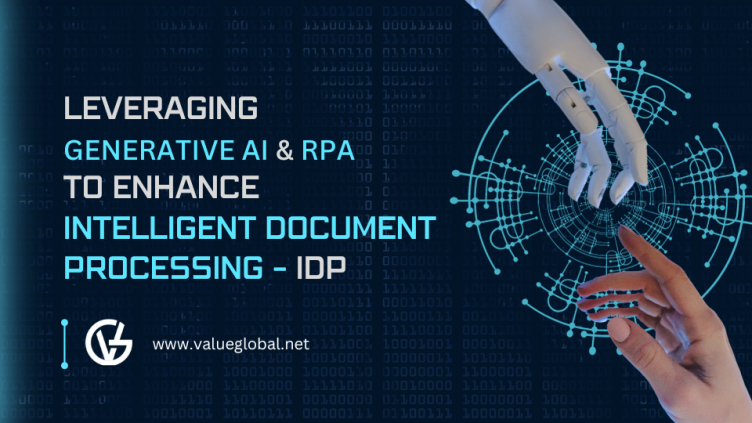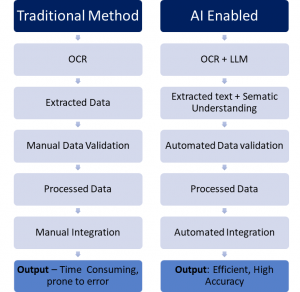
Leveraging Generative AI & RPA to Enhance Intelligent Document Processing – IDP
Business operations depend on document processing, which manages, analyzes, and extracts important information from numerous documents. For accurate decision-making and operational performance, firms must properly handle invoices, contracts, reports and handwritten notes. In the digital age, document overload, varied formats, inefficiencies, human errors, and scalability concerns make this activity difficult.
Businesses are increasingly using RPA and Generative AI to solve these problems. We examine Intelligent Document Processing (IDP) and its potential to revolutionize document processing with RPA and Generative AI.
IDP WORK FLOW

🔺Challenges in Document Processing
Overload: Businesses receive documents from various sources, leading to overwhelming volumes of information to process.
Diversity: Documents come in multiple formats, both physical and digital, making it challenging to handle a diverse range of layouts.
Inefficiency: Traditional document processing methods are time-consuming and resource-intensive, often leading to unproductive, repetitive tasks.
Human Error: Manual data entry and processing are prone to human error, resulting in financial discrepancies and compliance issues.
Scalability: As businesses grow, the volume of documents to be processed increases, and manual methods often cannot efficiently scale to meet the demands of a growing enterprise.
🔹The Promise of Intelligent Data Processing
In this data-driven age, businesses naturally turn to technology as the ultimate solution to their document processing problems. Technology has become essential to document processing due to the digital revolution, which has transformed enterprises. Let’s examine why adopting technology is natural and necessary to solve modern corporate document processing problems.
🟩 By implementing IDP solutions, businesses can achieve the following benefits:
Data Extraction: IDP can intelligently extract valuable information from documents, making it easier to analyze and use the data.
Efficiency: IDP can automate repetitive tasks, significantly reducing the time and resources required for document processing. This allows employees to focus on more value-added activities.
Accuracy: Automation reduces the risk of human error, ensuring data accuracy. This is crucial for financial transactions, audits, and compliance.
Scalability: These solutions can easily scale with the growth of a business, ensuring that document processing capabilities keep pace with increasing data volumes.
🌎Real-world Application: A multinational corporation with operations in various countries receives invoices from suppliers in different languages and formats. Their manual document processing system was overwhelmed, leading to payment delays and errors. By implementing IDP, they automated data extraction, improving accuracy, efficiency, and scalability.
💡Business Benefits: The implementation of IDP led to a significant reduction in processing time, resulting in faster payments to suppliers and a 20% decrease in error rates. This translated to cost savings and enhanced supplier relationships.
🤖 IDP and Robotic Process Automation (RPA)
IDP excels at document classification, data extraction, and data understanding, but it’s usually just the first step in many business processes. Following data extraction, RPA automates ERP or accounting software data entry. IDP and RPA boost business productivity. Document processing can be automated with IDP-capable RPA systems such as UiPath, Microsoft Power Automate, Automation Anywhere, Blue Prism, etc. They use OCR technologies to extract text from scanned documents. They automate data extraction from common documents like invoices and receipts using pre-built templates and automatic document classification.
🌎Real-world application with ROI: A financial institution processes numerous mortgage applications. After implementing IDP to extract key information from application documents, they used RPA to populate their financial systems with this data, reducing processing time and human error. This resulted in an ROI of 300% within the first year.
💡Business Benefits: The integration of IDP and RPA streamlined the mortgage application process, reducing manual data entry tasks by 80% and cutting processing time in half. This not only resulted in significant cost savings but also improved customer satisfaction due to faster approvals.
🚀Using Generative AI to Enhance IDP
While IDP works well, using Generative AI can help fine-tune document processing even more. Tools from OpenAI, Anthropic, Cohere and others provide Generative AI capabilities. Generative AI can help in the following ways:
- Generative AI’s language-understanding skills enhance document data extraction accuracy. Even with different document layouts, it understands context and finds vital information. It can be customized to extract document data. Training the model on relevant document samples lets it recognize names, dates, and addresses.
- Legal, technical, and sophisticated language are common in documents. Generative AI easily deciphers such text, improving the IDP’s language understanding. This is useful for processing legal documents like agreements and contracts.
- Generative AI can give IDP systems context and reasoning skills that can help them figure out how different pieces of information in documents relate to each other, which will ultimately lead to more accurate data extraction.
- For organizations dealing with documents in multiple languages, Generative AI can be used to automatically translate content, ensuring that language is not a barrier to document processing.
- Generative AI can be used to automate various steps of document processing, such as routing documents to the appropriate departments, generating responses, or performing quality checks.
- Generative AI, specifically Large Language Models (LLMs) can improve document processing substantially. LLMs can understand and generate text like humans, making them useful for Natural Language Processing (NLP). LLMs can process documents with different structures and styles, a major improvement over OCR and text extraction.
Traditional Method vs RPA – Generative Ai Enabled IDP

💡Key Takeaways
- IDP can transform how companies manage documents, extract data, and make decisions. Generative AI can improve document processing, language interpretation, and content production for organizations. Using IDP with RPA improves corporate operations.
- Generative AI and IDP extract and analyze data from documents efficiently. Complex, unstructured data processing improves document management and data-driven decisions.
- The IDP market’s astonishing growth suggests a future where enterprises are no longer burdened by paper or digital files. Instead, they’re heading toward a future where document processing doesn’t need much effort.
Ready to experience the transformative power of IDP with Generative AI and RPA?
Schedule an expert consultation today at sales@valueglobal.net
